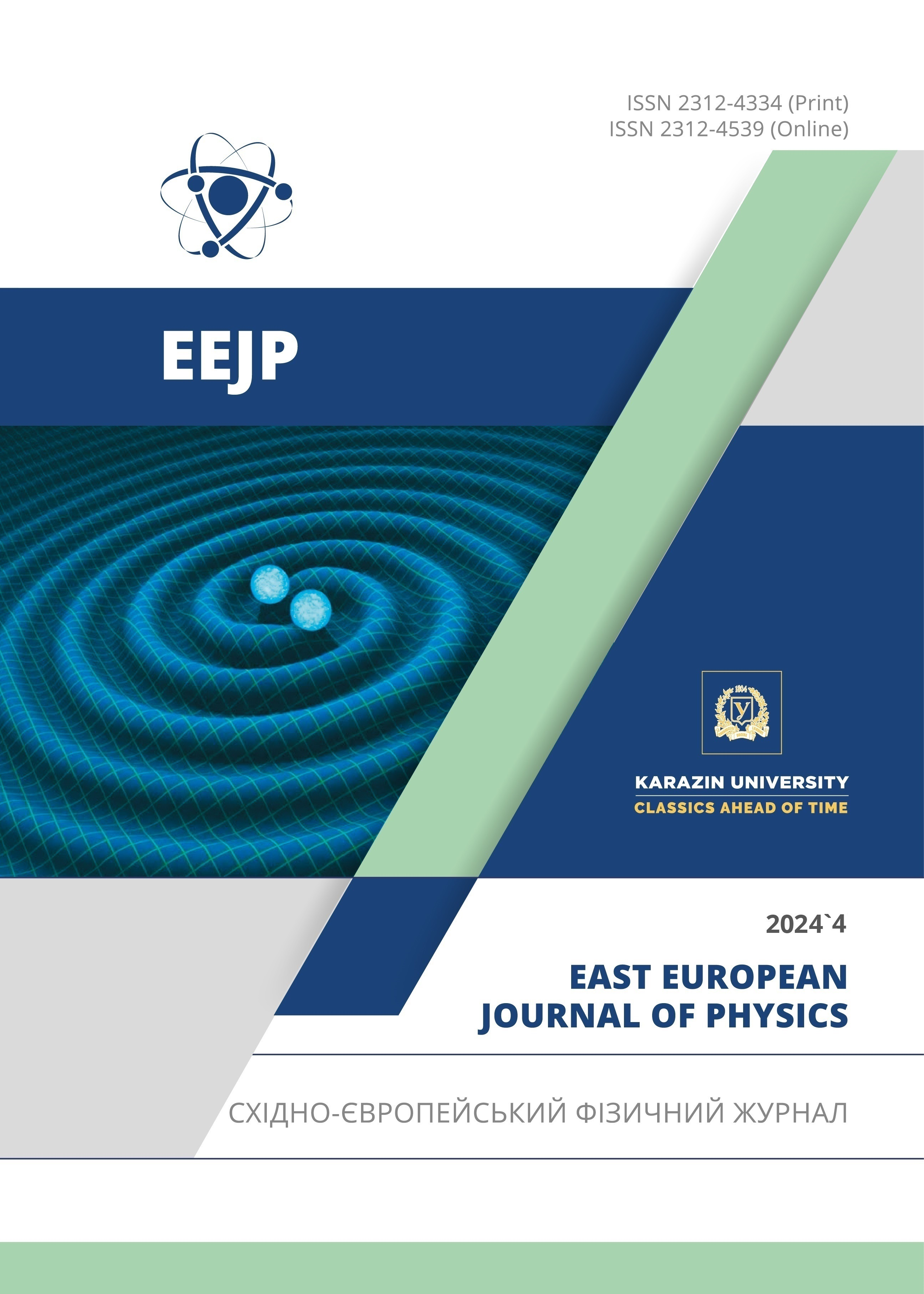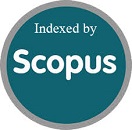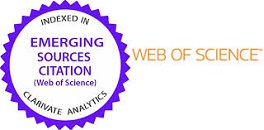Study of Defect Structure of Silicon Doped with Dysprosium Using X-Ray Phase Analysis and Raman Spectroscopy
Abstract
In this paper, the effect of doping silicon with dysprosium (Dy) on its structural and optical characteristics is investigated. Silicon n-Si was doped with dysprosium by thermal diffusion at 1473 K for 50 h. Raman spectroscopy and X-ray diffraction analysis were used for the analysis. The Raman spectroscopy results showed a main peak at 523.93 cm⁻¹, corresponding to n-Si optical phonons, with an increase in the intensity and full width at half maximum (FWHM) in n-Si<Dy> samples, indicating an improvement in the crystallinity of the structure. A decrease in the intensity of the peaks at 127.16 cm⁻¹ and 196.24 cm⁻¹, associated with amorphous structures, confirms a decrease in defects. The detection of a new peak at 307.94 cm⁻¹ indicates successful deposition of dysprosium as nanocrystallites associated with the 2TA phonon mode in the cubic phase of Dy2O3. X-ray diffraction analysis revealed characteristic structural lines indicating the (111) crystalline orientation and the presence of microdistortions in the lattice. Heat treatment and rapid cooling lead to a change in the intensity of structural lines, an increase in the second- and third-order lines, which indicates microstrains and a change in the size of subcrystallites. Doping of silicon with dysprosium improves the crystallinity of the structure, reduces the number of defects and forms polycrystalline layers on the surface consisting of SiO2 and Dy2O3 nanocrystals.
Downloads
References
A.I. Prostomolotov, Yu.B. Vasiliev, and A.N. Petlitsky, “Mechanics of defect formation during growth and heat treatment of single-crystal silicon,” (4), 1716–1718 (2011). http://www.unn.ru/pages/e-library/vestnik/19931778_2011_-_4-4_unicode/147.pdf
Sh.B. Utamuradova, Sh.Kh. Daliyev, J.J. Khamdamov, Kh.J. Matchonov, Kh.Y. Utemuratova, East Eur. J. Phys. (2), 274-278 (2024). https://doi.org/10.26565/2312-4334-2024-2-28
K.S. Daliev, S.B. Utamuradova, J.J. Khamdamov, and Z.E. Bahronkulov, "Electrophysical properties of silicon doped with lutetium,” Advanced Physical Research, 6(1), 42–49 (2024). https://doi.org/10.62476/apr61.49
Kh.S. Daliev, Sh.B. Utamuradova, J.J. Khamdamov, and M.B. Bekmuratov, “Structural Properties of Silicon Doped Rare Earth Elements Ytterbium,” East Eur. J. Phys. (1), 375-379 (2024). https://doi.org/10.26565/2312-4334-2024-1-37
K.S. Daliev, S.B. Utamuradova, A. Khaitbaev, J.J. Khamdamov, S.B. Norkulov, and M.B. Bekmuratov, “Defective Structure of Silicon Doped with Dysprosium,” East European Journal of Physics, (2), 283-287 (2024). https://doi.org/10.26565/2312-4334-2024-2-30
S.B. Utamuradova, K.S. Daliev, A.I. Khaitbaev, J.J. Khamdamov, J.S. Zarifbayev, and B.S. Alikulov, “Defect Structure of Silicon Doped with Erbium,” East European Journal of Physics, (2), 288-292 (2024). https://doi.org/10.26565/2312-4334-2024-2-31
S.B. Utamuradova, S.K. Daliev, A. Khaitbaev, J. Khamdamov, U.M. Yuldoshev, and A.D. Paluanova, “Influence of Gold on Structural Defects of Silicon,” East European Journal of Physics, (2), 327-335 (2024). https://doi.org/10.26565/2312-4334-2024-2-38
R.T.-P. Lee, K.-M. Tan, T.-Y. Liow, C.-S. Ho, S. Tripathy, G.S. Samudra, D.-Z. Chi, and Y.-C. Yeo, “Probing the ErSi1.7 Phase Formation by Micro-Raman Spectroscopy,” Journal of The Electrochemical Society, 154(5) H361-H364 (2007). https://doi.org/10.1149/1.2710201
J. Kedzierski, P. Xuan, E.H. Anderson, J. Bokor, T.J. King, and C. Hu, “Complementary silicide source/drain thin-body MOSFETs for the 20 nm gate length regime,” in: International Electron Devices Meeting 2000. Technical Digest. IEDM (Cat. No.00CH37138) (San Francisco, CA, USA, 2000), p. 57-60. https://doi.org/10.1109/IEDM.2000.904258
W.-J. Lee, and Y.-H. Chang, “Growth without Postannealing of Monoclinic VO2 Thin Film by Atomic Layer Deposition Using VCl 4 as Precursor,” Coatings, 8, 431 (2018). https://doi.org/10.3390/coatings8120431
K. Ali, S. Khan, M. Zubir, and M.Z.M. Jafri, “Spin-on doping (SOD) and diffusion temperature effect on re-combinations/ideality factor for solar cell applications,” Chalcogenide Letters, 9, 457–463 (2012). https://www.chalcogen.ro/457_KhuramAli.pdf
V. Mankad, S. Gupta, P. Jha, N. Ovsyuk, and G. Kachurin, “Low-frequency Raman scattering from Si/Ge nanocrystals in different matrixes caused by acoustic phonon quantization,” J. Appl. Phys. 112, 54318 (2012). https://doi.org/10.1063/1.4747933
T. Liu, P. Ge, and W. Bi, “The Influence of Wire Speed on Phase Transitions and Residual Stress in Single Crystal Silicon Wafers Sawn by Resin Bonded Diamond Wire Saw,” Micromachines (Basel), 12, (2021). https://doi.org/10.3390/mi12040429
G.-W. Lee, Y.-B. Lee, D.-H. Baek, J.-G. Kim, and H.-S. Kim, “Raman Scattering Study on the Influence of E-Beam Bombardment on Si Electron Lens,” Molecules, 26, (2021). https://doi.org/10.3390/molecules26092766
K. Adu, M. Williams, M. Reber, R. Jayasingha, H.R. Gutierrez, and G. Sumanasekera, “Probing Phonons in Nonpolar Semiconducting Nanowires with Raman Spectroscopy,” J. Nanotechnol. 2012, 264198 (2012). https://doi.org/10.1155/2012/264198
Y. Gogotsi, C. Baek, and F. Kirscht, “Raman microspectroscopy study of processing-induced phase transformations and residual stress in silicon,” Semicond. Sci. Technol. 14, 936 (1999). https://doi.org/10.1088/0268-1242/14/10/310
D. Casimir, H. Alghamdi, I.Y. Ahmed, R. Garcia-Sanchez, and P. Misra, “Raman Spectroscopy of Graphene, Graphite and Graphene Nanoplatelets,” in: 2D Materials, edited by C. Wongchoosuk, and Y. Seekaew, (IntechOpen, 2019). https://doi.org/10.5772/intechopen.84527
K. Maex, and M. Van Rossum, “Properties of Metal Silicides,” Inspec, (The institution of Electrical Engeineers, London, UK, 1995). p. 5. https://api.semanticscholar.org/CorpusID:92679751
Sh.B. Utamuradova, Kh.J. Matchonov, J.J. Khamdamov, and Kh.Y. Utemuratova, “X-ray diffraction study of the phase state ofsilicon single crystals doped with manganese,” New Materials, Compounds and Applications, 7(2), 93-99 (2023). http://jomardpublishing.com/UploadFiles/Files/journals/NMCA/v7n2/Utamuradova_et_al.pdf
S.Z. Zainabidinov, Sh.B. Utamuradova, et al., “Structural Peculiarities of the (ZnSe)1–x–y(Ge2)x(GaAs1–δBiδ)y Solid Solution with Various Nanoinclusions,” Journal of Surface Investigation: X-ray, Synchrotron and Neutron Techniques, 16(6), 1130–1134 (2022). https://doi.org/10.1134/S1027451022060593
I.L. Shulpina, R.N. Kyutt, V.V. Ratnikov, I.A. Prokhorov, I.Zh. Bezbakh, M.P. Shcheglov, “Methods of X-ray diffraction diagnostics of heavily doped semiconductor single crystals,” Journal of Technical Physics, 80(4), 105 (2010). https://journals.ioffe.ru/articles/viewPDF/9970
S.Z. Zainabidinov, A.S. Saidov, M.U. Kalanov, and A.Y. Boboev, “Synthesis, Structure and Electro-Physical Properties n-GaAs-p-(-(GaAs)1–x–y(Ge2)x(ZnSe)y Heterostructures,” App. Sol. Energy, 55(5), 291–308 (2019). https://doi.org/10.3103/S0003701X1905013X
K.V. Ravi, Imperfections and Impurities in Semiconductor Silicon, (Wiley, New York, 1981).
A.N. Tereshchenko, Dislocation luminescence in silicon with different impurity composition, PhD Thesis, Chernogolovka, 2011.
M.A. Lourenço, Z. Mustafa, W. Luduczak, L. Wong, R.M. Gwilliam, and K.P. Homewood, “High temperature dependence Dy3+ in crystalline silicon in the optical communication and eye-safe spectral regions,” Optics Letters, 38(18), 3669-3672 (2013). https://doi.org/10.1364/OL.38.003669
I.P. Suzdalev, and P.I. Suzdalev, “Nanoclusters and nanocluster systems. Organization, interaction, properties,” Advances in Chemistry, 70(3), 203-240 (2001). https://doi.org/10.1070/RC2001v070n03ABEH000627
N.V. Gokhfeld, Electron microscopic study of atomically ordered alloys based on Cu-Pd and Cu-Au, subjected to severe plastic deformation and subsequent annealing, PhD Thesis, Ekaterinburg, 2019. http://elar.urfu.ru/handle/10995/95084
Copyright (c) 2024 Khodjakbar S. Daliev, Sharifa B. Utamuradova, Jonibek J. Khamdamov, Shahriyor B. Norkulov, Mansur B. Bekmuratov

This work is licensed under a Creative Commons Attribution 4.0 International License.
Authors who publish with this journal agree to the following terms:
- Authors retain copyright and grant the journal right of first publication with the work simultaneously licensed under a Creative Commons Attribution License that allows others to share the work with an acknowledgment of the work's authorship and initial publication in this journal.
- Authors are able to enter into separate, additional contractual arrangements for the non-exclusive distribution of the journal's published version of the work (e.g., post it to an institutional repository or publish it in a book), with an acknowledgment of its initial publication in this journal.
- Authors are permitted and encouraged to post their work online (e.g., in institutional repositories or on their website) prior to and during the submission process, as it can lead to productive exchanges, as well as earlier and greater citation of published work (See The Effect of Open Access).








